We test and review fitness products based on an independent, multi-point methodology. If you use our links to purchase something, we may earn a commission. Read our disclosures.
As a certified personal trainer, I think the glute muscles are some of the most accessible to train in the comfort of your own home. So, if you have a goal to increase the strength (and size) of your butt muscles, I’ve got you covered with 16 different glute exercises at home that you can try this week.
Some movements will challenge you with your own bodyweight, while others might require some additional resistance. The beautiful part about strength training is you can adapt any of these movements for your fitness level, your space, and the equipment you have on hand—whether that be a set of resistance bands, dumbbells, kettlebells, or a barbell.
Why Should You Care About Your Glutes?
Your butt is a large group of muscles and includes the gluteus maximus, gluteus medius, and gluteus minimus. The average person (including myself) sits for several hours at a time for work or while driving. You might not give too much thought to your butt on a daily basis, but this group of muscles functions to help you run, walk uphill, and stand from a seated position. The glutes also support your torso and stabilize your pelvis1.
Not only are the gluteus muscles important for every day function, keeping the glutes strong can help you avoid chronic pain. In fact, there are studies that show a correlation between underdeveloped glutes with both knee2 pain and back3 pain.
How to Perform Glute Exercises at Home
I have a list of 16 glute exercises below. By picking and choosing from this list, you can customize your own butt workout to do at home. To get started, use whatever equipment you have on hand or perform with bodyweight alone—it’s totally up to you!
After you’ve had some reps under your belt, to eliminate any plateaus in your glute gains you’ll need to keep challenging the muscles (aka progressive overload). You can increase the difficulty of any exercise with more weight, repetitions, or sets. You can also decrease rest time or increase range of motion. If a movement starts to feel easy, it’s not time to coast, it’s time to up the ante.
Here’s a guideline of how to incorporate these exercises:
- Choose 4-6 of the following glute exercises
- Perform 3-4 sets of 10 (or more) repetitions of each movement
- Add one glute-focused day into your routine or sprinkle in 4-6 exercises throughout the week
16 Minimal Equipment Glute Exercises at Home
If you’re ready to up the volume on your glute training, don’t worry about adding anything new to your home gym—chances are you can get started today with what you have right now.
Additionally, I wouldn’t be surprised if these exercises not only get your glutes pumped, but your quads and hamstrings, too.
1. Glute Bridge
Why do Them: Glute bridges can help beginners target glute muscles with low-impact to the rest of the body. In addition, an advanced lifter movement can help warm up the glutes for compound lifts like squats and deadlifts.
How to do a glute bridge:
- Lie face up on the floor, knees bent, and feet shoulder-width apart and flat on the floor.
- Make sure your shins are vertical with your ankles and knees stacked up.
- Ever-so-slightly tip your pelvis toward your chin so that your lower back presses into the floor (this helps keep your core braced and prevents overextension at the top).
- Keeping your feet flat, press into the floor and lift your butt, until you fully extend your hips.
- Flex the glutes at the top and hold for a brief moment before slowly lowering your butt to the floor and repeating the range of motion.

2. Hip Thrust
Why do Them: A hip thrust is like the older brother to the glute bridge. The movement is more difficult because the range of motion has increased and it recruits muscles from your core, quads, and hamstrings.
How to do a hip thrust:
- Sit with feet flat on the floor in front of a bench, couch, or chair.
- Position your feet hip-width apart and about 6 inches away from your glutes.
- Keeping your feet in place on the floor, adjust your upper back so your shoulder blades are supported by your chosen support behind you and your butt is hovering off the ground.
- Push into your feet and flex your glutes to drive your hips into full extension so that your quads, core, and upper body are parallel to the floor.
- Slowly come back to the floor (or hovering, depending on bench height) and repeat.
Pro tip: At the top of the motion, keep your back flat and avoid overextending into an arched position.

3. Single-Leg Hip Thrust
Why do Them: Single-leg movements are beneficial so you can isolate one leg at a time and find any imbalances you might have from left-to-right.
How to do a single-leg glute bridge:
- Set up the same way you would for a traditional hip thrust as outlined above.
- Lift your left foot off the ground and bend your left leg at a 90-degree angle.
- Press into the floor with your right foot to generate enough force to lift your butt off the floor.
- Make sure your hips stay stable with the one-leg position as you bring your hips into full extension.
- Slowly lower back your starting position and repeat.
Pro tip: Try to keep your non-working leg in a 90-degree position, otherwise you might be tempted to flail and gain momentum.
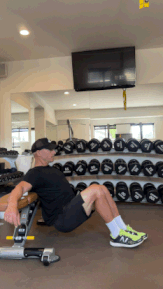
4. Frog Pump
Why do Them: Similar to a glute bridge, the frog pump is low-impact and isolates the glutes. It can also help to mobilize your hips through a greater range of motion.
How to do a frog pump:
- While lying with your back on the floor, bring the bottoms of your feet to touch and your knees bent.
- Similar to a glute bridge, you’ll tip your pelvis toward your chin so that your lower back presses gently into the floor.
- Lift your butt off the floor and flex your glutes until you fully extend your hips.
- Try to keep your angles out and away from each other during the entire movement.
- Hold for a brief moment before letting your butt down to the floor.
- Repeat for reps.
5. Clam Shell
Why do Them: Clam shells are the essential low-impact way to isolate the gluteus medius, which is a muscle that functions to stabilize the pelvis1.
How to do a clam shell:
- Lie down on your side with your pelvis perpendicular to the floor, knees bent, and right and left knees stacked.
- Without flexing the quads, lift your top knee away from your bottom knee by just a few inches.
- Hold the top position for a second before lowering the top knee and repeating for repetitions.
- Repeat on the other side.
Pro tip: This is a subtle movement where you’ll need to end the range of motion before your back or core muscles start to move to overcompensate for the glutes. The idea to target the gluteus medius, which is the outer part of your hips and butt.
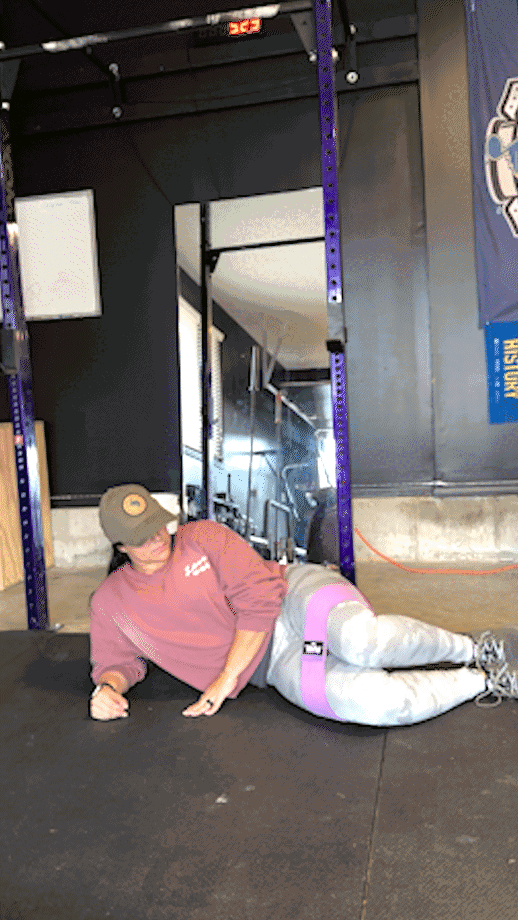
6. Fire Hydrant
Why do Them: You get the same benefits of targeting your gluteus medius as the clam shell, with the added challenge of bracing your core and stabilizing your back.
How to do a fire hydrant:
- Start in a quadruped position with both your hands and knees on the floor (hands under shoulders and knees under hips).
- In this starting position, keep your back straight and your core braced.
- Start the movement by lifting your right leg sideways off to the right a few inches away from the midline of your body.
- Keep your right knee bent at 90 degrees.
- Hold the top position before lowering your knee back down to the floor and repeating.
Pro tip: The fire hydrant is a similar butt exercise to the clam shell, but adds extra core challenge in the quadruped position.
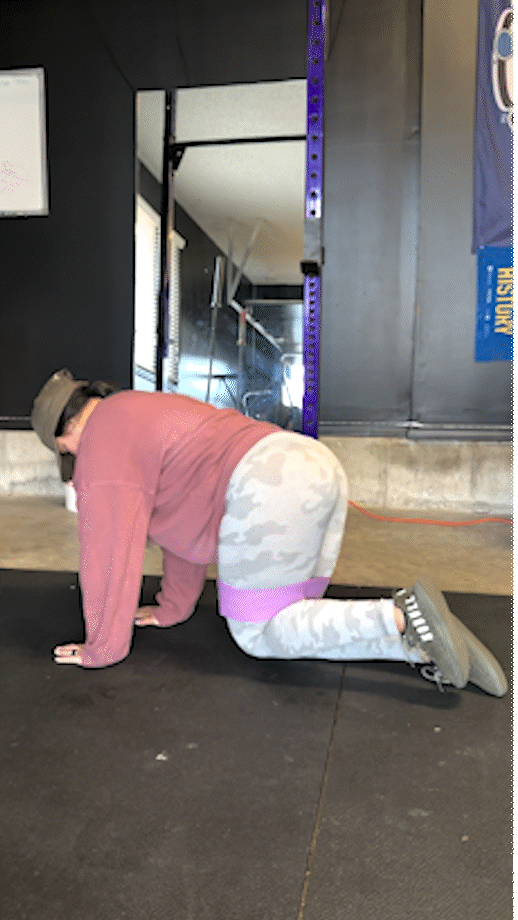
7. Standing Kickback
Why do Them: Standing kickbacks are beneficial because they are low-impact and isolate the gluteus maximus. It’s also a movement that can be effective with bodyweight, ankle weights, bands, or a functional trainer.
How to do a kickback:
- Brace yourself against a wall or squat rack with your back straight, but hinged slightly forward.
- Stand with your bodyweight on your left leg, pick up your right foot and bend your right leg.
- With your right leg bent, drive your right heel backward and fully extend your leg as if you’re kicking something behind you.
- Purposely flex your butt muscles at the top.
- Draw your right knee back to the bent position and repeat for reps.
Pro tip: For more challenge, anchor a long loop band to a squat rack and position your foot in the apex of the band (as pictured above).
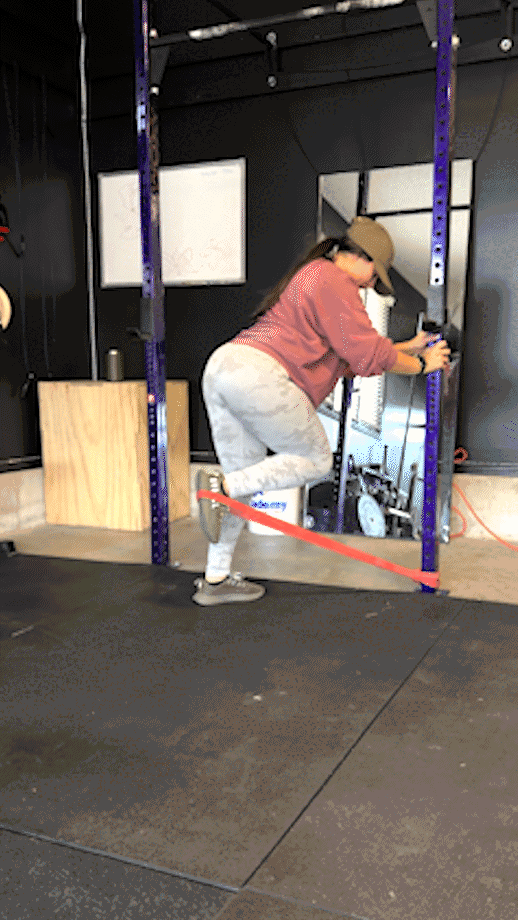
8. Donkey Kick
Why do Them: This movement has all the same benefits of a standing kickback but without having to get off the floor, which is great for older folks or anyone with mobility issues.
How to do a donkey kick:
- In a quadruped position with your hands and knees on the floor, keep your core braced and your back flat.
- Initiate the donkey kick by lifting your left leg while maintaining a 90-degree angle at the knee and the sole of your shoe facing the ceiling.
- Without overextending your back, purposely flex your left glute before lowering your knee to the floor.
- Repeat all reps on the left side then switch to your right leg.
Pro tip: You can manipulate your range of motion and turn the donkey kick into a pulse for even more muscle activation.
9. Reverse Lunge
Why do Them: Reverse lunges are a compound movement that will not just help you strengthen your glutes. The reverse lunge is beneficial for the entire lower body and your balance, too.
How to do a reverse lunge:
- In a standing position start with your feet hip-width apart and upper body relaxed.
- Keep your right foot planted, step back on the ball of your left foot and allow your left leg to bend as you lower the left leg down toward the floor.
- Keep your head and trunk upright while your lower down.
- Full range of motion is when both front and back legs reach a 90-degree angle (your back knee might not touch the floor)
- At the bottom position, generate force into your front foot and drive your lower body back into the standing position and repeat for reps.
Pro tip: For a more challenging reverse lunge, you can hold a kettlebell in one hand, two dumbbells (one in each hand), or even hold a weight in the front rack position.

10. Bulgarian Split Squat
Why do Them: Bulgarian split squats add extra challenge to a traditional split squat or lunge by increasing your range of motion. You can gain better balance by practicing these.
How to do a Bulgarian split squat:
- Start by placing a bench, box, or a few bumper plates stacked up so you can elevate your back foot for this exercise.
- Once that is set, position your body so that the bench is behind you.
- With your feet hip-width apart, lift your right leg, and place the ball of your right foot on the bench behind you.
- From this position, the right leg should be slightly bent and not at full extension.
- Start lowering your body and make sure your left leg (the front leg) comes to a 90-degree angle. This is where the motion stops, you don’t have to touch your back knee to the ground.
- From the bottom position, generate force into your left (front) leg and rise to the starting position.
- Repeat the motion with your back foot on the bench for the whole set.

11. Goblet Squat
Why do Them: The goblet squat can strengthen both glutes and quads. The squat is also a functional movement to help you improve daily movements like getting up from a chair, tending to your garden, or picking up a heavy bag of dog food from the floor.
How to do a goblet squat:
- To start your squat position, place your feet flat on the ground and hip-width apart.
- With your hands out in front of your chest, hold a dumbbell, kettlebell, or any other weight you have on hand.
- To initiate the squat, push your knees out away from one another and let your butt slowly lower until your thighs are slightly lower than parallel to the floor.
- Your torso should lower down in a straight line with your chest mostly upright.
- At the bottom of your squat (determined by your mobility), start generating force into your feet and flexing your glute muscles to drive yourself back up into the standing position.
- In the standing position, hold your glute flex for a moment before you slowly lower into your next repetition.

12. Single-Leg Deadlift
Why do Them: Single leg deadlifts are useful for isolating the hamstrings and glutes. It also targets one leg at a time, which can help you assess any imbalances in your strength.
How to do a single-leg deadlift:
- Your starting position will be feet directly under your hips and one light dumbbell in your right hand.
- Balance your body weight on your left leg and pick up your right foot slightly off the ground.
- With control, hinge your hips back and focus on the feeling of the hamstrings activating on your left leg.
- Lower the dumbbell in your right hand and hinge until your torso becomes parallel with the floor.
- Keep your right leg fairly straight and directly behind you while you hinge (try not to let the right leg flail to the side).
Pro tip: If you’re new to this, brace yourself on a wall, squat rack, or nearby table for additional support balancing.
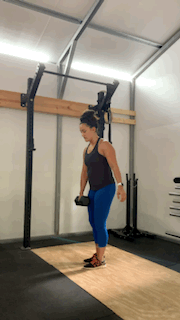
13. Romanian Deadlift
Why do Them: The Romanian deadlift is an essential movement for developing hamstring and glute strength because you don’t touch the weights down to meet the floor, which means your leg muscles are under constant tension.
How to do a Romanian deadlift:
- Start by standing hip-width apart and a dumbbell in each hand with your hands at your sides.
- Keep your back straight throughout the exercise by positioning your shoulder blades back and down—a cue I like to use with clients is to pretend you can tuck your scapula into your back pockets.
- With your upper back locked into position and your back flat, hinge your hips back and let your dumbbells essentially drag down the front of your legs.
- Keep your legs fairly straight throughout the hinge and let the dumbbells lower as much as you can with your back still flat.
- When you hit the end of your range of motion, start flexing your glutes to initiate standing back up again (without rounding your back).
- At the top, hold the glute flex momentarily before lowering into your next rep.

14. Step Up
Why do Them: Step ups are a functional unilateral excuse that not only strengthens the glutes, hamstrings, and quads—it also helps you get more comfortable with your balance.
How to do a step-pup:
- Start by placing a plyo box or bench on level ground.
- Stand about six inches (or less) in front of the bench and put your left foot fully on the bench.
- Your left leg is the working leg, so you will generate force into the box with your left foot.
- Press into your left foot and drive your hips up to standing position with both feet on the bench.
- To lower, step the right foot down all the way to the ground, followed by your left foot.
- You can now repeat with the opposite leg leading on the bench.
Pro tip: Don’t feel it in the glutes as much as you want? Mentally and physically focus on driving into the heel that is on the box for more posterior chain activation.

15. Deficit Sumo Squat
Why do Them: A deficit sumo squat is a bit more advanced than the traditional squat but the wide stance can help activate the muscles that run along your inner thigh.
- This exercise requires two of any of the following: plyo boxes, weight benches, or a stack or weight plates.
- With your boxes placed about a foot apart, have a medium-weighted dumbbell or kettlebell situated between the boxes.
- Stand with one foot on each box, positioned a bit wider than hip-width apart (to the degree you feel comfortable).
- Grab the weight in your hands and let your arms hang with the weight hanging between your legs.
- Keep your chest upright and initiate the squat by pushing your knees open and slowly lowering your butt until hips are parallel to the floor or lower if you can.
- Make sure both knees are driving out and not caving inward.
- Generate force by pushing into the boxes with both feet and flex the glutes to help you get back upright into the starting position.
- Repeat with proper form for reps.

16. Good Morning
Why do Them: Good mornings activate your lower back, glutes, hamstrings, and core and can be utilized as a learning tool for general hip hinging movements.
How to do a good morning:
- Before you start, keep in mind that a good morning is just a hip hinge, but the load on your upper body rather than your lower body.
- To start, secure a long looped band (like the Rogue Monster band) under your feet, shoulder-width apart.
- Squat down and place the other end of the loop band behind your neck or even slightly on your upper back.
- Now that the band is around your neck, stand upright with a gentle bend in the knees.
- Initiate the good morning by hinging your hips back and keeping your back flat.
- Focus your attention on the hamstring activation while you lower and bring your chest so it is parallel to the floor.
- From here, flex your glutes to assist standing back up and bringing hips to full extension.
- Repeat with your back flat for the whole set.
Pro tip: If you’re new to the good morning, ditch the loop and place your hands gently behind your head. Practice the movement with your bodyweight before adding band resistance.

Glute Exercises at Home: Final Thoughts
With so many options for glute exercises at home, which one will you try first? If you’re new to butt-specific work, start with a glute bridge and focus on what it feels like to flex your glutes. We sit so much, so it might take a few reps to get the feeling.
Whether you’re an experienced lifter or new to fitness, here is a quick summary on why you might appreciate being able to train glutes in the comfort of your own home:
- All the glute exercises on this list are meant to be performed with minimal equipment.
- You can progress any of these glute exercises with band tension or weights.
- Strengthening your glutes can help with low back pain.
- Stronger (and bigger) glutes can help you change your body composition.
Glute Exercises at Home: Q&A
How can I build my glutes at home?
If you’re short on time or don’t want to add too much variation to an already established fitness routine, you can add bodyweight glute bridges and hip thrusts to build your glutes without any equipment. If you want an extensive list of exercises to help build strength and the size of your glutes, be sure to check out all 16 glute exercises we included in this article.
What are 3 exercises that strengthen the glutes?
There are so many different exercises that help you develop strong glutes, but in my professional opinion, the top three glute exercises are the hip thrust, squat, and Romanian deadlift.
How many days a week should I work on my glutes?
As a certified personal trainer, I recommend training your glutes two to three times a week if you’re looking to increase both size and strength of the muscle group. That said, you don’t have to do a specific glute workout two to three times a week, just make sure you’re incorporating four to six different glute exercises per week.
References
- Elzanie A, Borger J. Anatomy, Bony Pelvis and Lower Limb, Gluteus Maximus Muscle. [Updated 2022 Mar 28]. In: StatPearls [Internet]. Treasure Island (FL): StatPearls Publishing; 2022 Jan-.
- Barton CJ, Lack S, Malliaras P, Morrissey D. Gluteal muscle activity and patellofemoral pain syndrome: a systematic review. Br J Sports Med. 2013;47(4):207-214. doi:10.1136/bjsports-2012-090953
- Jeong UC, Sim JH, Kim CY, Hwang-Bo G, Nam CW. The effects of gluteus muscle strengthening exercise and lumbar stabilization exercise on lumbar muscle strength and balance in chronic low back pain patients. J Phys Ther Sci. 2015;27(12):3813-3816. doi:10.1589/jpts.27.3813
Further reading

We look at these low-price, high-value adjustable dumbbells in our NordicTrack Dumbbell review. Read more

Our CAROL Bike review will give you the full inside scoop on this science-based cardio machine with great functionality. Read more

Are these dumbbells already the best in the industry? Find out in our REP x PÉPIN Fast Series Adjustable Dumbbell Review. Read more

Trying to build strong shoulders using dumbbells? Check out one of our favorite shoulder workouts with dumbbells here! Read more

